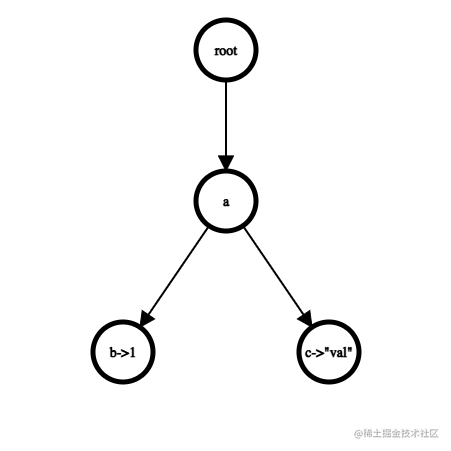CMU 15-445 Project 0 實現字典樹
原文連結:https://juejin.cn/post/7139572163371073543
專案准備
本文對應 2022 年的課程,Project 0 已經更新為實現字典樹了。C++17 的開發環境建議直接下載 CLion,不建議自己瞎折騰。
測試
$ mkdir build && cd build
$ cmake -DCMAKE_BUILD_TYPE=DEBUG ..
$ make starter_trie_test
$ ./test/starter_trie_test
執行上面的指令,你會得到如下輸出,這不表示該專案的 5 個測試用例沒過,而是沒有執行。
[==========] Running 0 tests from 0 test suites.
[==========] 0 tests from 0 test suites ran. (0 ms total)
[ PASSED ] 0 tests.
YOU HAVE 5 DISABLED TESTS
需要修改 test/primer/starter_trie_test.cpp 檔案,移除測試名 DISABLED_ 字首。
// TEST(StarterTest, DISABLED_TrieNodeInsertTest)
TEST(StarterTest, TrieNodeInsertTest)
格式化
$ make format
$ make check-lint
$ make check-clang-tidy-p0
偵錯紀錄檔
LOG_INFO("# Pages: %d", num_pages);
LOG_DEBUG("Fetching page %d", page_id);
專案介紹
使用支援並行的字典樹實現一個鍵值儲存,字典樹是一種高效的排序樹,用於檢索指定鍵值。這裡假設鍵都是非空的可變長度字串,但事實上鍵可以是任意型別。

上圖所示字典樹中儲存了:HAT、HAVE、HELLO 三個鍵。

上圖所示字典樹儲存了:ab=1、ac="val" 兩組鍵值。
專案實現
只需要修改一個檔案:src/include/primer/p0_trie.h
專案已經定義好了類和成員變數,以及需要實現的成員函數的簽名,可以新增輔助變數或函數,但不能修改已有變數和函數簽名。
任務一
檔案中定義了 Trie、TrieNode、TrieNodeWithValue 三個類,建議先實現單執行緒版本,再改並行版本,類中的成員變數和成員函數都有註釋。
任務二
實現並行安全的字典樹,可以使用 BusTub 的 RwLatch 或 C++ 的 std::shared_mutex。
一些 C++ 的基操
一年多沒寫 C++ 了,用慣了 Go,突然用 C++ 寫的腦殼疼,沒用過 C++ 的小夥伴可能想編譯通過都費勁,這裡貼一下需要了解的 C++ 特性。
移動語意
std::unique_ptr<T> 表示唯一的指向型別為 T 的物件的指標,因此需要使用移動語意 std::move,程式碼中 children_ 的型別巢狀了 std::unique_ptr<T>,也需要使用移動語意。
TrieNode(TrieNode &&other_trie_node) noexcept {
key_char_ = other_trie_node.key_char_;
is_end_ = other_trie_node.is_end_;
children_ = std::move(other_trie_node.children_);
}
構造父類別
TrieNodeWithValue 是 TrieNode 的子類,構造子類時,如果沒有手動在子類別建構函式中構造父類別,就會呼叫父類別的預設建構函式,而程式碼中父類別是沒有預設建構函式的,所以需要手動在子類中構造父類別。
需要使用 std::forward<TrieNode> 轉發右值參照。
TrieNodeWithValue(TrieNode &&trieNode, T value) : TrieNode(std::forward<TrieNode>(trieNode)) {
this->value_ = value;
this->is_end_ = true;
}
父子指標轉換
TrieNodeWithValue 是模板類,沒法辦使用多型,Trie::GetValue 需要將 unique_ptr<TrieNode> 轉換為 TrieNodeWithValue<T>* 後呼叫 TrieNodeWithValue::GetValue。
std::unique_ptr<TrieNode> uptr = std::make_unique<TrieNodeWithValue<T>>('a', T());
dynamic_cast<TrieNodeWithValue<T>*>(&(*uptr))->GetValue();
可能有更優雅的辦法,但我實在是想不出來了,C++ 可真難寫啊。
所有權規避
std::unique_ptr<T> 的傳遞一定是使用移動語意轉移 T 物件地址的所有權,但也可以不獲取所有權存取 T 物件的地址,程式碼裡的註釋也引導我們使用這種方式。
std::unique_ptr<int> uptr(new int(1));
std::cout << *uptr << std::endl; // 1
auto *p = &uptr;
*(*p) = 2;
std::cout << *uptr << std::endl; // 2
程式碼實現
大部分程式碼按照註釋一步一步來就沒問題,課程規定不公開程式碼,所以這裡只列一些難點。
迴圈迭代
這裡給出一個模版,對於尾節點和非尾節點,一般需要不同的操作。
auto curr = &root_;
size_t i = 0;
while (i + 1 < key.size()) {
curr = (*curr)->GetChildNode(key[i]);
i++;
}
// end_node
curr = (*curr)->GetChildNode(key[i]);
節點轉換
在插入流程中,當迭代到最後一個字元時,發現已經有了一個 TrieNode 型別的節點,需要轉換為 TrieNodeWithValue 型別。
* When you reach the ending character of a key:
* 2. If the terminal node is a TrieNode, then convert it into TrieNodeWithValue by
* invoking the appropriate constructor.
不熟悉 C++ 的話這個操作可能有點困難,這裡給出程式碼,這一層又一層的括號和解除參照確實不夠優雅,但一時間也想不到其他好辦法。
(*curr) = std::make_unique<TrieNodeWithValue<T>>(std::move(*(*curr)), value);
節點刪除
根據程式碼註釋的提示,Remove 函數是要遞迴刪除的,這裡給出遞迴的框架。
bool remove_inner(const std::string &key, size_t i, std::unique_ptr<TrieNode> *curr, bool *success) {
if (i == key.size()) {
*success = true; // Remove 的返回值,表示成功刪除
(*curr)->SetEndNode(false);
return !(*curr)->HasChildren() && !(*curr)->IsEndNode();
}
bool can_remove = remove_inner(key, i + 1, (*curr)->GetChildNode(key[i]), success);
if (can_remove) {
(*curr)->RemoveChildNode(key[i]);
}
return !(*curr)->HasChildren() && !(*curr)->IsEndNode();
}
remove_innner 的返回值表示傳入節點是否可以刪除,可以刪除的條件是該節點無子節點且非尾節點。函數內判斷當前節點的子節點是否可以刪除,並返回當前節點是否可以刪除。出口是遞迴到了傳入 key 的尾節點,取消尾節點標記,並返回是否可以刪除。該函數呼叫前還需要判斷一下 key 是否存在。
空模板變數值
GetValue 的返回值是一個模板型別,錯誤的時候直接 return T(),正常情況下,需要轉換 TrieNode 為 TrieNodeWithValue 中獲取值,上文提過該父子類轉換的辦法。
template <typename T>
T GetValue(const std::string &key, bool *success) {
return T();
return dynamic_cast<TrieNodeWithValue<T> *>(&(*(*curr)))->GetValue();
}
並行安全
這個其實很簡單,前 4 個測試都通過了,Insert、Remove、GetValue 三個函數開始和結束位置加鎖和解鎖就可以了,需要注意的是這三個函數如果彼此呼叫會死鎖,比如 Insert 裡面呼叫 GetValue 判斷 key 是否存在。
這裡提供一個 Go 語言中 defer 解鎖的簡易實現,如果你不知道 defer 就在每個返回的地方都解鎖就可以。
class RLock {
ReaderWriterLatch *latch_;
public:
RLock(ReaderWriterLatch *latch) : latch_(latch) { latch_->RLock(); }
~RLock() { latch_->RUnlock(); }
};
class WLock {
ReaderWriterLatch *latch_;
public:
WLock(ReaderWriterLatch *latch) : latch_(latch) { latch_->WLock(); }
~WLock() { latch_->WUnlock(); }
};
使用方式如下,以 Remove 為例。
bool Remove(const std::string &key) {
WLock w(&latch_);
if (!Exist(key)) {
return false;
}
bool success = false;
remove_inner(key, 0, &root_, &success);
return success;
}
寫在最後
動手開始專案前,可以先去 leetcode 過一遍 實現 Trie (字首樹),先能寫出簡單的字典樹再動手。如果需要程式碼的話可以私信我。如果想做資料庫的工作歡迎找我內推(恰點內推獎金)。
